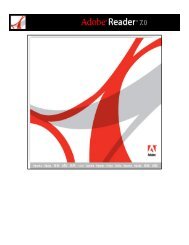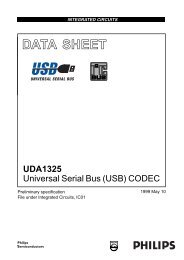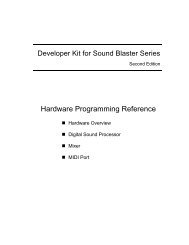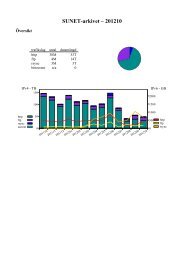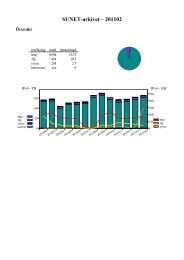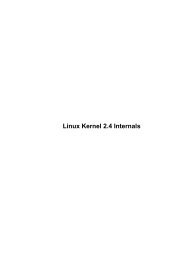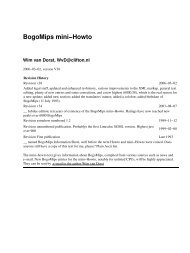Audio Codec '97 Revision 2.1
Audio Codec '97 Revision 2.1
Audio Codec '97 Revision 2.1
You also want an ePaper? Increase the reach of your titles
YUMPU automatically turns print PDFs into web optimized ePapers that Google loves.
AC ‘97 Component Specification <strong>Revision</strong> <strong>2.1</strong><br />
minimum of four audio frame times following the frame in which the power down was triggered. When AC-link<br />
powers up it indicates readiness via the <strong>Codec</strong> Ready bit (input slot 0, bit 15).<br />
See AC ’97 <strong>2.1</strong> Appendix D for additional discussion of power management.<br />
5.<strong>2.1</strong>.1 Cold AC ‘97 Reset<br />
A cold reset is achieved by asserting RESET# for the minimum specified time. By driving RESET# low, BIT_CLK,<br />
and SDATA_OUT will be activated, or re-activated as the case may be, and all AC ‘97 control registers will be<br />
initialized to their default power on reset values.<br />
RESET# is an asynchronous AC ‘97 input.<br />
See AC ’97 <strong>2.1</strong> Appendix D for additional discussion of power management.<br />
5.<strong>2.1</strong>.2 Warm AC ‘97 Reset<br />
A warm AC ‘97 reset will re-activate the AC-link without altering the current AC ‘97 register values. A warm reset<br />
is signaled by driving SYNC high for a minimum of 1us in the absence of BIT_CLK.<br />
Within normal audio frames SYNC is a synchronous AC ‘97 input. However, in the absence of BIT_CLK, SYNC is<br />
treated as an asynchronous input used in the generation of a warm reset to AC ‘97.<br />
AC ‘97 MUST NOT respond with the activation of BIT_CLK until SYNC has been sampled low again by AC ‘97.<br />
This will preclude the false detection of a new audio frame.<br />
See AC ’97 <strong>2.1</strong> Appendix D for additional discussion of power management.<br />
35<br />
May 22, 1998




